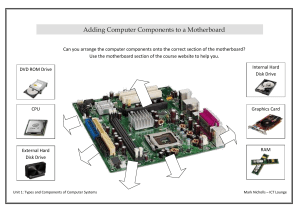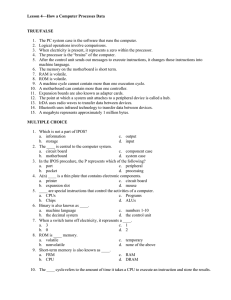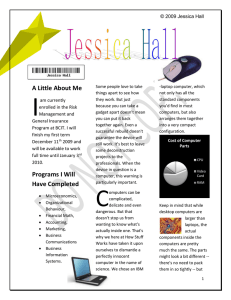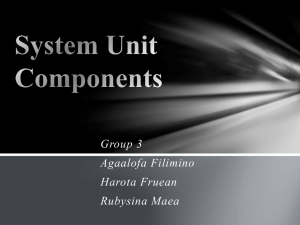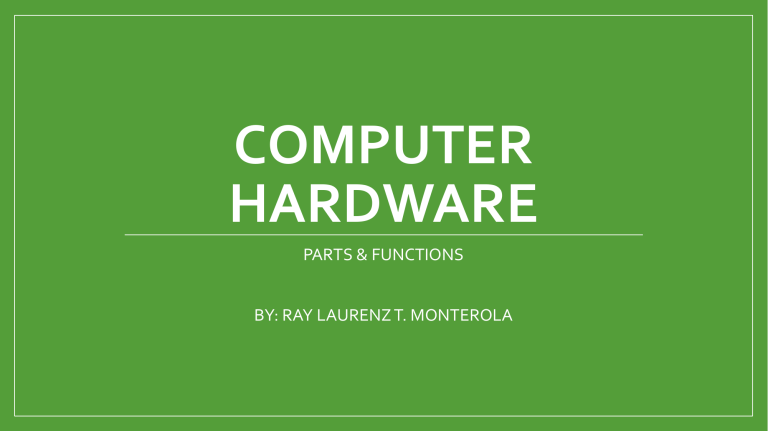
COMPUTER HARDWARE PARTS & FUNCTIONS BY: RAY LAURENZ T. MONTEROLA External Components Mouse The mouse is a pointing device that sends control signals into the computer. It is used to move the cursor (usually arrow icon) on the screen and to perform click actions. Back Monitor It is used to display data in visual form (which can only be seen). The images it display are where the user gets information. Back Keyboard This contains set of keys that are used to input characters (letters, numbers) and control signals into the computer. Back Automatic Voltage Regulator It protects the computer from changes in the electricity that may damage the computer components. It regulates the voltage that goes to the computer. Back System Unit It serves as a container of the computer’s internal parts (motherboard, CPU, etc.) Back THE INTERNAL COMPONENTS Internal Components Power Supply Unit It converts the main alternating current into low-voltage direct current that is supplied to other parts. A power supply unit has its own fan. Hard Disk Drive It is the main storage device of the computer. It is where most of the files of the computer (such as the ones found in Desktop) are stored. Optical Disc Drive It reads or writes data into optical discs (CD, DVD, Blu-ray Disc). Random Access Memory Module It is the temporary storage device of the computer. It is used to hold the data that the computer is working on. The black rectangles are called RAM chips. Central Processing Unit This is referred to as the computer’s brain as it does the processing job of the computer. This means that it is responsible for manipulating the data. CPU Fan and Heatsink These two components work together in keeping the CPU from overheating. The metal is called the heatsink as it conducts heat from the CPU while the CPU fan blows the air to the heatsink. See next slide to know the airflow System Fan This is found at the left side panel and the back panel of the system unit. It directs the flow of air in the system unit. Motherboard It is the main circuit board of the computer that connects all other parts. PARTS OF THE MOTHERBOARD Expansion Slots These are where the expansion cards such as modem card and graphics card are installed. These are different types of slots. RAM Slots These are where the RAM modules are installed. Northbridge Located between the CPU socket, Expansion slots, and RAM slots. It coordinates the flow of data between the CPU, graphics card, and RAM Southbridge Located below the expansion slots, the Southbridge handles all of the computer’s input/output functions. The location of the two Chipsets BIOS Chip It stands for Basic Input/Output System. It contains the program that checks devices to know if the computer is ready to startup. CMOS RAM It is the one that holds data used by the BIOS or Operating System. These data includes time, date, BIOS password. CMOS Battery It provides the power used by the CMOS RAM so that even when the computer is off, the CMOS RAM can still keep data (this means time and date will not be reset). Back Panel Ports Located at the back of the motherboard. This is where most of the computer peripherals are connected. These peripherals include the keyboard, mouse, and printer. Front Panel Headers It is mostly located at the left and front side of the motherboard. Most computers have three front panel headers: system panel headers, audio headers, USB headers. CPU Socket It is where the CPU is installed. 20+4 Pin ATX Main Power Connector It is where the 20+4 Pin ATX Main Power Connector of the PSU is connected. 4 Pin ATX 12V Power Connector It is where the 4 Pin ATX 12V Power Connector of the PSU is connected. CPU Fan Header It is where the CPU fan is connected to get its power.


